Mission: Impact podcast & blog
Build a better world without becoming a martyr to your nonprofit cause
Listen on:
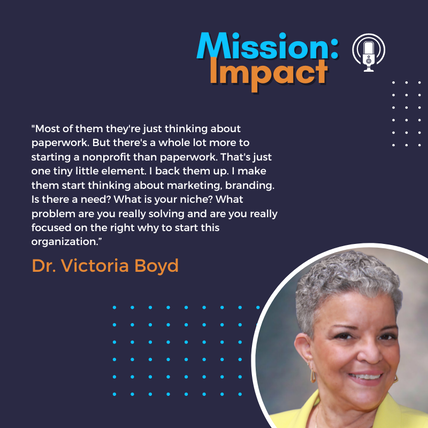 In episode 96 of Mission: Impact, Carol Hamilton and Dr Victoria Boyd discuss
07:34 - Common Misconceptions about Starting Nonprofits what to focus on instead 16:22- The Logic Model as the heart beat of the organization 25:29- **Defining your Unique Value Proposition 27:39 Building shared leadership intentionally Guest Bio:
Dr. Victoria Boyd Author, Trainer, Consultant, and founder of The Philantrepreneur Foundation. Host of the Nonprofit Corner Podcast. Important Links and Resources: The Philantrepreneur Foundation - https://drvictoriaboyd.com/foundation/ Nonprofit Corner Podcast: https://nonprofitcorner.org/home Related Episodes: Episode 17: Program Evaluation with Wendy Wolfe Click "Read More" for a transcript of the interview 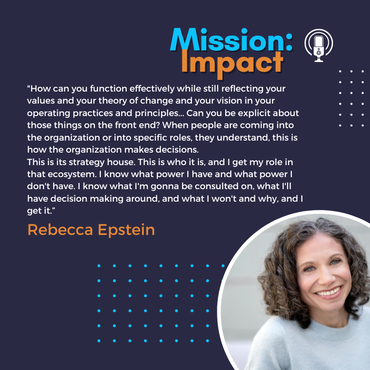 In episode 94 of Mission: Impact, Carol Hamilton and Rebecca Epstein discuss the article that Rebecca wrote with Mistinguette Smith published in the Nonprofit Quarterly in 2023. Paving a Better Way: What’s Driving Progressive Organizations Apart and How to Win by Coming Together. The conversation between Rebecca and Carol covers the intricacies and challenges of leadership and organizational dynamics within the nonprofit sector, particularly in the context of social justice work. Their discussion touches upon generational conflicts, power dynamics, organizational clarity, and strategies for effective leadership, especially in the recent crises we have all experienced over the past several years. Episode highlights: Generational and Cultural Dynamics in Nonprofits [00:08:30] The recent increased conflict within organizations between leaders and staff, often on generational and racial lines. How these conflicts are similar and different to those of the past. Addressing Internal Conflicts and Building Resilience [00:15:30] Conflicts within organizations, such as public call outs and accusations of racism as well as the push for structural changes. Organizational Clarity and Strategy - [00:20:30] The importance of organizational clarity regarding power and decision-making, and how it should reflect an organization's values and strategies. The Challenge of Aligning Strategy and Leadership - [00:25:30] The challenges organizations face in aligning their leadership style with their identity and mission as well as aligning expectations across segments of staff. Addressing Trauma in Nonprofits - [00:35:30] Understanding and addressing trauma embedded in social justice work – the trauma that stems from the issue the organization is addressing, intergenerational trauma, personal and interpersonal trauma. How might trauma at all these levels be addressed responsibly? Current Trends and Challenges The dialogue offers nonprofit leaders a range of insights and considerations for fostering healthy, effective, and resilient organizations that can navigate the complexities of social change work. Guest Bio:
Becca Epstein is a coach and consultant to social justice organizations and their leaders with over 20 years of experience in community organizing, organizational development, and nonprofit leadership. Becca is a co-founder of The Management Center, a former Vice President at Planned Parenthood Federation of America, and a convener of the “Paving a Better Way” working group. Her practice focuses on leaders, organizations, and movements confronting strategic challenges, seeking transformation, and advancing equity and justice. Becca holds an MPA in Nonprofit Management and Public Policy from NYU, a BA in Anthropology from Amherst College, and is a Certified Professional Coach. Important Links and Resources: Paving a Better Way: What’s Driving Progressive Organizations Apart and How to Win by Coming Together by Rebecca Epstein and Mistinguette Smith Building Resilient Organizations: Toward Joy and Durable Power in a Time of Crisis by Maurice Mitchell Learning From an Intergenerational Blowup Over Social Justice by Steve Kaagan & John Hagan Rebecca Epstein: https://www.linkedin.com/in/rebecca-epstein-797aa75/ https://www.beccaepsteincoaching.com/ Internal Family Systems - No Bad Parts: https://bookshop.org/p/books/no-bad-parts-healing-trauma-and-restoring-wholeness-with-the-internal-family-systems-model-richard-schwartz/16396062?gad_source=1&gclid=Cj0KCQjw-_mvBhDwARIsAA-Q0Q7ZNqD5nvZg5Rc0AW1G0doLAO72cWnAFeCHvmKdI5QkEjpu1QDdtWIaAtc-EALw_wcB Polarities - Polarity Partnerships: https://www.polaritypartnerships.com/ Related Episodes: These articles were also discussed on: Episode 75: Co-creation with Carol Hamilton and Danielle Marshall Nature of the employee-employer relationship/what is work: Episode 78: Renegotiating our relationship with work with Carol Hamilton Episode 85: Building equitable compensation frameworks with Mala Nagarajan "Click "Read More" for a transcript of the interview. 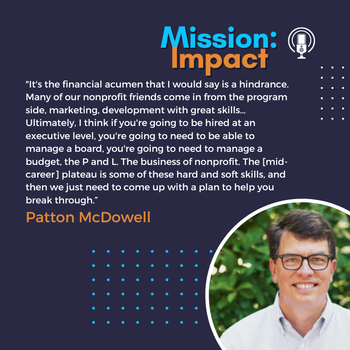 In episode 92 of Mission: Impact, Carol Hamilton and Patton McDowell explore the multi-generational nonprofit workforce, discussing the unique hurdles and opportunities that come with each stage of a non-profit career—from emerging leaders grappling with gaining practical experience to mid-career professionals encountering a plateau, and up to executive directors feeling isolated at the top. They underscore the importance of adaptability, continuous learning, and the benefits of strategic personal planning. Show highlights: Generational Workforce Challenges - [00:07:00] Discussion on the challenges faced by different generations in the nonprofit sector. Opportunity and Experience for Emerging Leaders - [00:08:05] Patton talks about the emerging leader generation facing the issue of opportunity and joy market entry difficulties Mid-Career Plateau - [00:19:25] Patton introduces the idea of a "mid-career plateau" and how to overcome it. Non-Traditional Career Paths - [00:22:00] Carol discusses lateral moves and specialization as alternatives to traditional progression. Executive Leadership Loneliness - [00:24:22] Patton discusses the isolation felt by those in executive leadership roles. Co-Executive Director Model - [00:29:00] Carol asks Patton about shared leadership roles and his views on them. Predictable Turnover - [00:33:00] Carol reflects on predictable turnover and proactive recruitment approaches. Organizational Exchanges - [00:39:10] Patton and Carol discuss the benefits of organizational exchanges and site visits. Personal Retreat for Leaders - [00:42:20] Patton recommends nonprofit leaders take personal retreats for strategic planning and Carol speaks on her own practice of personal strategic planning. Guest Bio:
Patton is the Founder of PMA Nonprofit Leadership, a coaching and consulting firm specializing in leadership development, fundraising, and strategic planning for nonprofits. He led fundraising efforts at two universities after starting his career at Special Olympics International. He's a Master Trainer for AFP Global, hosts the podcast Your Path to Nonprofit Leadership, and authored a best-selling book of the same name. He holds a bachelor's degree from UNC Chapel Hill, an MBA from Queens University of Charlotte, and a Doctorate from the University of Southern California. Patton currently serves as an Executive in Residence at the Jeb E. Brooks School of Public Policy at Cornell University. Important Links and Resources: Patton McDowell - https://www.linkedin.com/in/pattonmcdowell/ PMA Nonprofit https://www.pmanonprofit.com/ Charlie Gilkey - https://www.productiveflourishing.com/ Click "Read More" for a transcript of the interview. 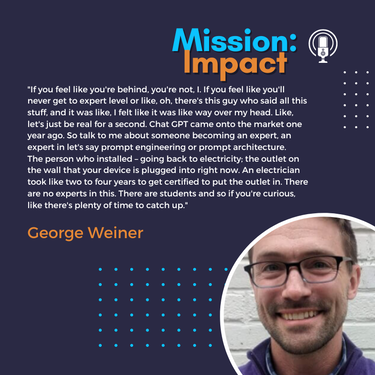 In episode 91 of Mission: Impact, Carol Hamilton and George Weiner discuss the intersection of artificial intelligence (AI) and the nonprofit sector. They delve into the significance of AI in the sector, emphasizing the need for strategic adoption and policy development. The conversation then shifts to the integration of AI into everyday tools They cover practical applications of AI and discuss crafting AI policies as well as the potential for AI to enhance nonprofit operations, particularly in grant writing and reporting. Episode highlights: [00:06:00] AI Adoption and Policy in Nonprofits [00:08:00] Hype Cycle of AI: [00:11:00] - AI in Everyday Life: [00:13:00] - AI for Nonprofit Content Creation [00:15:00] Crafting Nonprofit AI Policies and Guidelines [00:16:00] - Integrating AI in Nonprofits: [00:20:00] - Avoiding Overextension with AI: [00:24:00] - Practical AI Tools for Nonprofits: [00:27:00] Time Saving vs. Time Reallocation with AI [00:29:00] AI in Grant Writing: Guest Bio:
George Weiner is the Chief Whaler, WholeWhale.com. He co-founded CTOs For Good, PowerPoetry.org. He is a Dad, and a nonprofit geek. Important Links and Resources: WholeWhale.com George Weiner Cause Writer AI https://causewriter.ai/ The Smart Nonprofit by Beth Kanter and Allison Fine Click "Read More" for Transcript 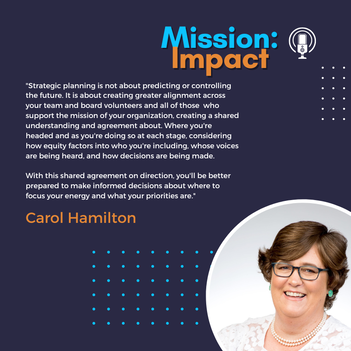 In episode 90 of Mission: Impact, Carol Hamilton goes solo and talks about:
Strategic planning:
Kick Off
Keeping the Plan Fresh
Important Links and Resources: Common Mistakes Organizations Make in Strategic planning: https://www.gracesocialsector.com/store/p13/strategic_plan_mistakes.html Be in touch ✉️ Subscribe to Carol’s newsletter at Grace Social Sector Consulting 💻 Give us feedback on the show 🌟 Like what you heard? Please help share the podcast by leaving a rating & review. 😀 Connect with Carol Hamilton ➡️ LinkedIn |
Archives
April 2024

Grace Social Sector Consulting, LLC, owns the copyright in and to all content in and transcripts of the Mission: Impact podcast, as well as the Mission: Impact blog with all rights reserved, including right of publicity.
|
Telephone301-857-9335
|
info[at]gracesocialsector.com
|
Grace Social Sector Consulting, LLC, owns the copyright in and to all content in, including transcripts and audio of the Mission: Impact podcast and all content on this website, with all rights reserved, including right of publicity.
|